Soccer, the beautiful game that captivates millions worldwide, is more than just 22 players chasing a ball. It’s a complex dance of strategy, skill, and teamwork. But have you ever wondered about how many players actually make up a soccer team?
A standard soccer team consists of 11 players on the field, each fulfilling specific roles that contribute to the overall strategy. Let’s dive into the world of soccer positions, team structure, and the rules that govern this globally beloved sport.
The Beautiful Game’s Roster: More Than Just 11 Players
When you think of a soccer team, you might picture 11 players on the field. But that’s just the tip of the iceberg. The full match-day squad is a carefully crafted unit designed to tackle any situation that might arise during play.
how many players on a soccer team: A Brief History
The number of players in soccer team hasn’t always been set in stone. In the early days of the sport, teams could field as many players as they wanted. Can you imagine the chaos? It wasn’t until 1863 that the Football Association in England standardized the game, setting the number of players at 11 per side.
Interesting fact: Before standardization, some matches saw teams with over 20 players each! The field must have been quite crowded.
The Magic Number: 11 on the Field, But That’s Not the Whole Story
Today, a standard soccer team consists of 11 players on the field. But here’s where it gets interesting:
- Starting XI: These are the 11 players who begin the match.
- Substitutes: Depending on the competition, teams can have 3-12 substitutes on the bench.
- Total Squad Size: For professional matches, the full match-day squad typically includes 18-23 players.
“Football is nothing without fans.” – Jock Stein
This quote reminds us of the often-overlooked “12th man” – the fans. Their energy and support can dramatically influence the game’s outcome.
Breaking Down the Squad: From Starting XI to Bench Warmers
Let’s take a closer look at the components of a soccer team:
- Starting XI: These players are chosen based on their form, fitness, and the tactical approach for the match.
- Substitutes: These players can change the course of the game. They’re selected for their ability to impact the match or cover for potential injuries.
- Reserve Players: Some competitions allow additional reserve players who can be called up in case of injuries or other unforeseen circumstances.
Fun Fact: The record for the most substitutions used in a single FIFA World Cup match is 6, set in the 2018 final between France and Croatia.
The Importance of Squad Depth
Having a strong bench is crucial for success in modern soccer. Here’s why:
- Tactical Flexibility: Different players offer different strengths, allowing managers to adapt to various game situations.
- Injury Coverage: A deep squad can withstand injuries without a significant drop in quality.
- Competition for Places: When players have to fight for their spot, it often leads to improved performance.
Positions on the Pitch: A Tactical Breakdown
Understanding soccer positions is crucial to grasping the game’s strategy. Here’s a comprehensive look at the roles players fill:
Goalkeeper: The Last Line of Defense
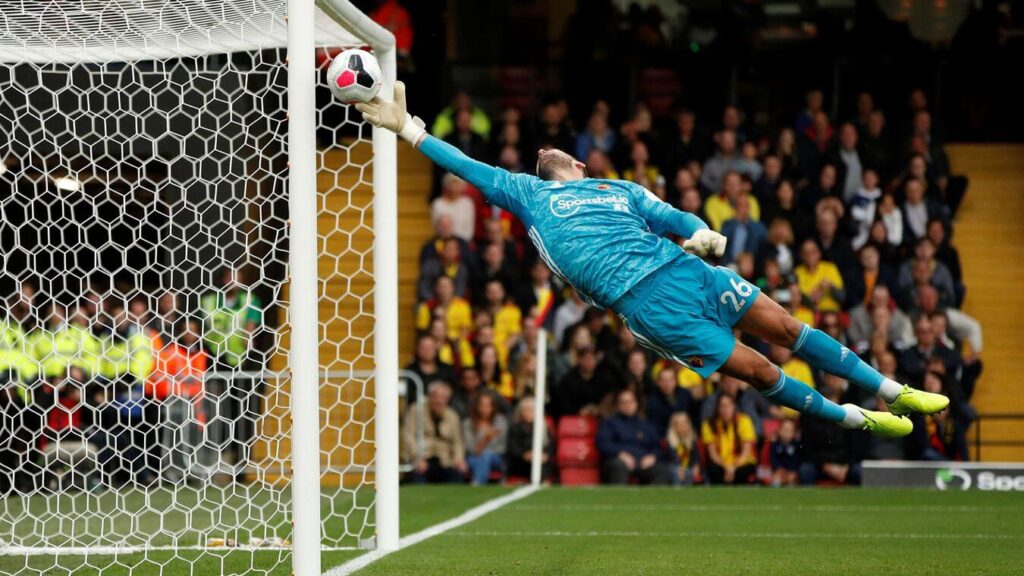
- Key Traits: Quick reflexes, good positioning, strong communication
- Primary Responsibility: Prevent goals by any means necessary (within the rules, of course!)
- Notable Example: Manuel Neuer, known for his “sweeper-keeper” style
Defenders: Guardians of the Goal
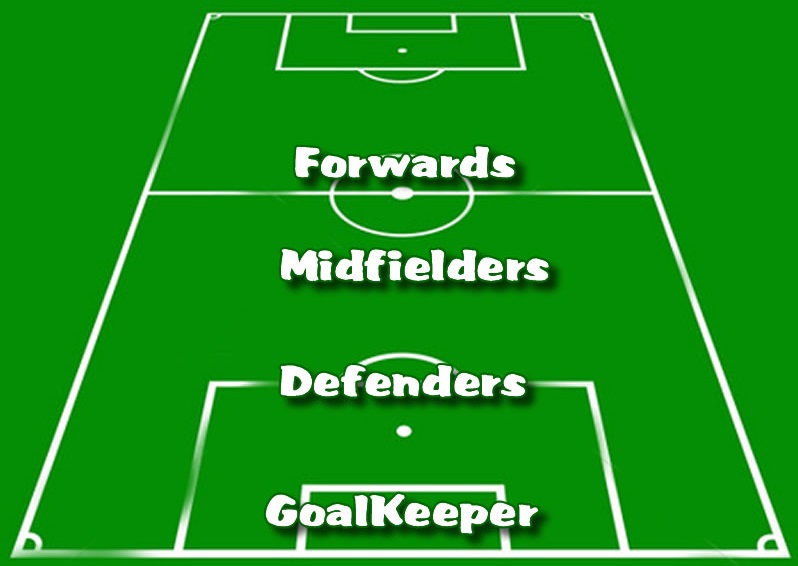
- Center-backs
- Role: Defend against opposing forwards, organize the defense
- Key Skills: Strength, aerial ability, tactical awareness
- Notable Example: Virgil van Dijk, renowned for his composure and leadership
- Full-backs and Wing-backs
- Role: Defend against wingers, provide width in attack
- Key Skills: Speed, stamina, crossing ability
- Notable Example: Trent Alexander-Arnold, known for his attacking contributions
Midfielders: The Engine Room of the Team
- Defensive Midfielders
- Role: Shield the defense, break up opposition attacks
- Key Skills: Tackling, positioning, passing
- Notable Example: N’Golo Kanté, famous for his tireless work rate
- Central Midfielders
- Role: Control the tempo of the game, link defense and attack
- Key Skills: Vision, passing range, work rate
- Notable Example: Kevin De Bruyne, known for his playmaking abilities
- Center Attacking Midfielders (CAM)
- Role: Create scoring opportunities, support the forwards
- Key Skills: Creativity, dribbling, shooting
- Notable Example: Bruno Fernandes, renowned for his goal contributions
Forwards: The Goal-Scoring Specialists
- Strikers
- Role: Score goals, lead the attacking line
- Key Skills: Finishing, movement, strength
- Notable Example: Robert Lewandowski, known for his clinical finishing
- Wingers
- Role: Provide width in attack, create chances for strikers
- Key Skills: Pace, dribbling, crossing
- Notable Example: Mohamed Salah, famous for his cutting inside and scoring
When the Numbers Change: Substitutions and Send-offs
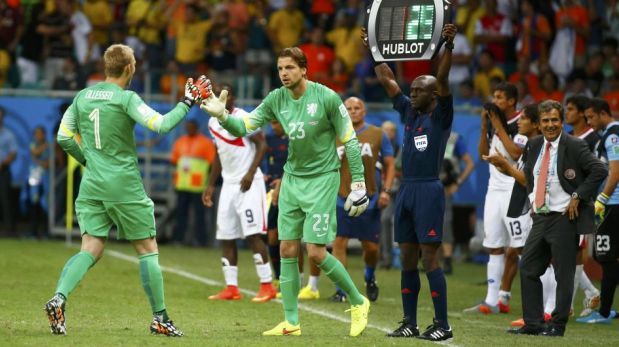
The dynamic nature of soccer means that team composition can change during a match. Here’s how:
Substitutions: The Game-Changers
- Most leagues allow 3 substitutions per game
- Some competitions (like the English FA Cup) allow 4 or 5 substitutions
- Once substituted, a player cannot return to the field
Tactical Use of Substitutions:
- Injury Replacement: When a player is unable to continue
- Tactical Change: To shift the team’s formation or playing style
- Time-Wasting: In the closing minutes when a team is ahead
- Fresh Legs: To inject energy into the team, especially in midfield or attack
Yellow or Red Cards: Playing with Fewer Than 11
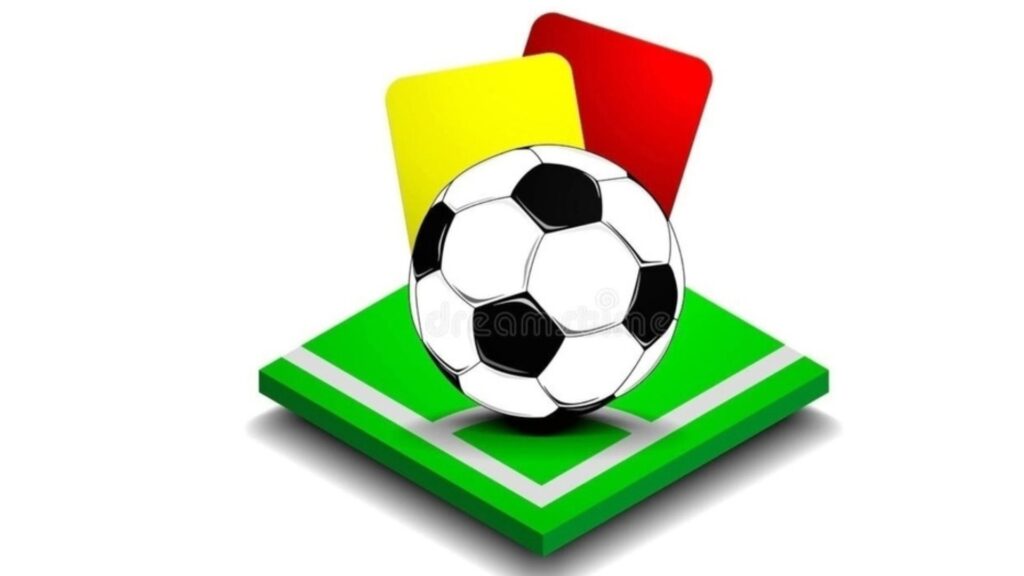
- A yellow card serves as a warning
- Two yellow cards result in a red card and player ejection
- A straight red card also results in ejection
- Teams must play with fewer players if a player is sent off
Impact of Playing with Fewer Players:
- Tactical reshuffling is often necessary
- Increased physical demands on remaining players
- Potential for counter-attacking opportunities for the opposition
The Seven-Player Minimum: When a Match Can’t Continue
If a team has fewer than 7 players eligible to play due to injuries or send-offs, the match is abandoned. This rarely happens but is an important rule to know.
Youth Soccer: Adapting the Beautiful Game for Developing Players

Youth soccer adapts the game to suit different age groups and developmental stages. Here’s a breakdown:
| Age Group | Players on Field | Field Size | Game Duration | Ball Size |
| U6-U8 | 4v4 or 5v5 | 30×20 yards | 4×10 minutes | Size 3 |
| U9-U10 | 7v7 | 55×35 yards | 2×25 minutes | Size 4 |
| U11-U12 | 9v9 | 70×45 yards | 2×30 minutes | Size 4 |
| U13+ | 11v11 | Full-size pitch | 2×35+ minutes | Size 5 |
This gradual progression helps young players develop skills and understanding of the game as they grow.
Benefits of Small-Sided Games for Youth
- More touches: Fewer players mean more ball contact for each child
- Simplified decision-making: Less crowded field makes it easier to read the game
- Increased engagement: All players are constantly involved in the action
- Better skill development: More opportunities to practice dribbling, passing, and shooting
Soccer Around the World: How Team Sizes Vary
While the 11-player standard is universal in professional soccer, there are some variations:
- Five-a-side Soccer: Popular in indoor leagues and futsal
- Played on a smaller pitch with smaller goals
- Emphasizes close control and quick decision-making
- Beach Soccer: Typically played with 5 players per team
- Played on sand, which affects ball movement and player mobility
- High-scoring due to the challenging surface for goalkeepers
- Paralympic Soccer: 7-a-side format for players with cerebral palsy
- Played on a smaller field with adjusted rules to accommodate players’ abilities
The Laws of the Game: FIFA’s Rulebook
FIFA’s “Laws of the Game” is the soccer bible. Here are key points from Law 3: The Players:
- A match is played by two teams, each with a maximum of 11 players; one must be the goalkeeper
- A match may not start or continue if either team has fewer than 7 players
- The maximum number of substitutes is usually 3 in official competitions
Case Study: In the 2019-2020 season, FIFA allowed leagues to temporarily increase the number of substitutions to 5 per team due to the COVID-19 pandemic, showing how the laws can adapt to extraordinary circumstances.
Recent Changes to the Laws
- Handball Rule: Clarified to reduce controversial decisions
- Goal Kick: Ball no longer needs to leave the penalty area to be in play
- Dropped Ball: Now uncontested to reduce unfair advantages
Beyond the Players: The Extended Team
A soccer team is more than just the players on the field. The extended team includes:
- Coaches
- Head Coach: Overall strategy and team selection
- Assistant Coaches: Specialized training and tactical support
- Goalkeeping Coach: Focused training for goalkeepers
- Medical Staff
- Team Doctor: Oversees player health and fitness
- Physiotherapists: Injury treatment and prevention
- Support Staff
- Analysts: Study opponents and team performance
- Nutritionists: Manage players’ diets
- Equipment Managers: Ensure all necessary gear is available
The Role of Data Analysis in Modern Soccer
Data analysis has become crucial in professional soccer. Teams employ analysts to:
- Study opposition tactics and player tendencies
- Analyze team performance metrics
- Identify potential transfer targets
- Optimize training regimens
Tactical Implications of Team Size
The number of players on a team significantly influences tactical approaches:
- Formations: Common formations like 4-4-2, 4-3-3, or 3-5-2 are based on 11 players
- Playing with Fewer Players: Teams often switch to more defensive formations when a player is sent off
Popular Formations and Their Characteristics
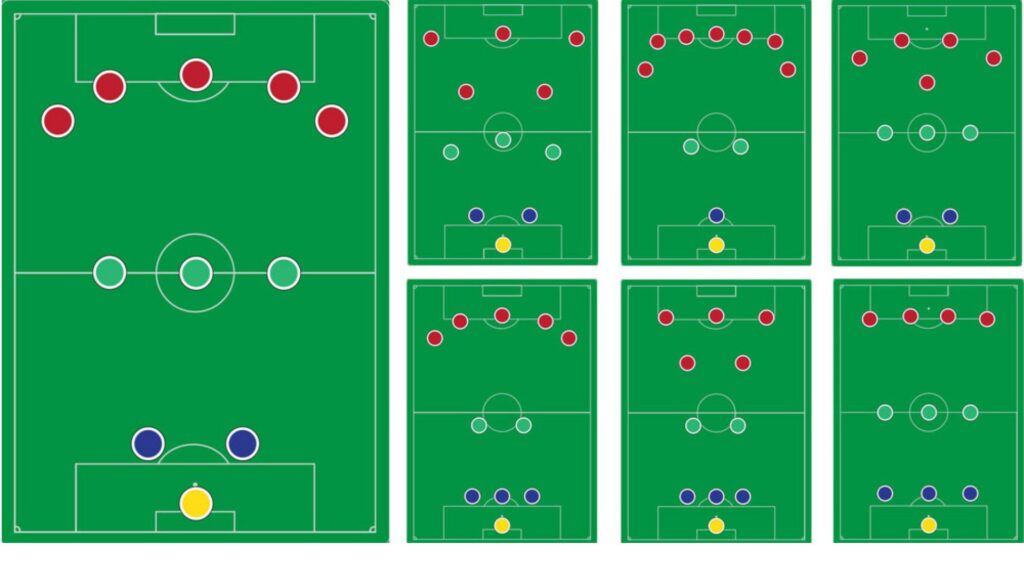
- 4-4-2
- Balanced formation with two strikers
- Relies on strong midfield work rate
- 4-3-3
- Attacking formation with width provided by wingers
- Requires a disciplined defensive midfielder
- 3-5-2
- Utilizes wing-backs for both attack and defense
- Strong central presence with three center-backs
- 4-2-3-1
- Flexible formation adaptable to both attack and defense
- Relies on a strong attacking midfielder (number 10)
You May Also Like This: What Are Soccer Friendlies? A Comprehensive Guide
The Impact of Substitutions on Game Dynamics
Substitutions can dramatically change the course of a match. Here’s how:
- Tactical Shifts: Introducing players with different skill sets can alter the team’s playing style
- Energy Boost: Fresh legs can reinvigorate a team, especially in the latter stages of a game
- Defensive Reinforcement: Adding defenders can help protect a lead
- Offensive Push: Bringing on attacking players when trailing can increase goal-scoring chances
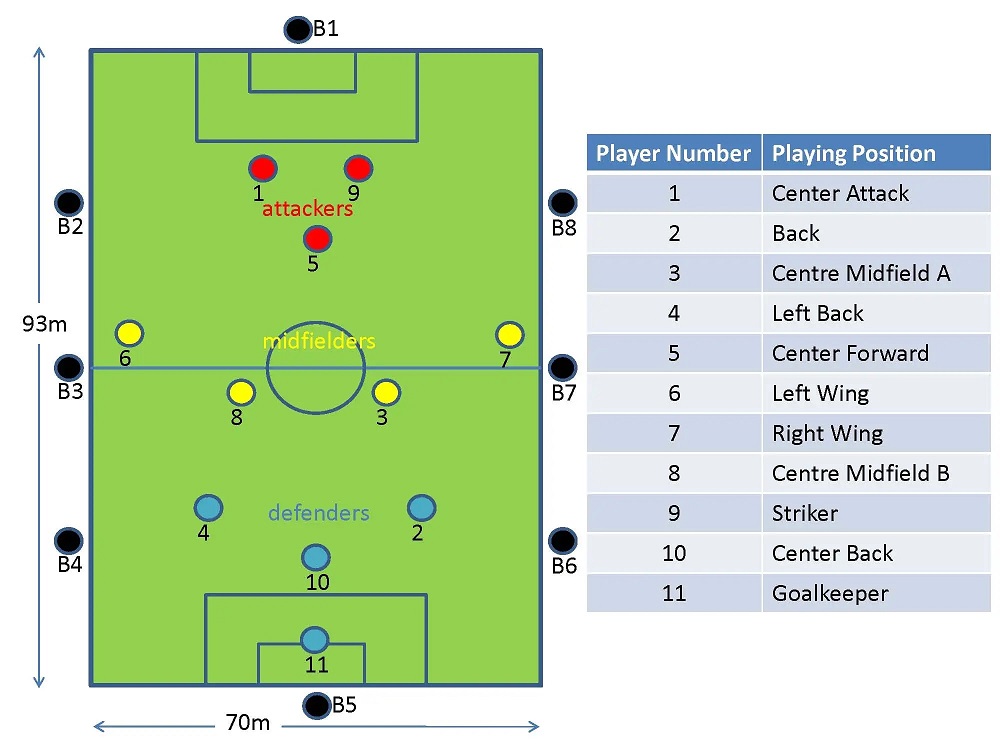
Soccer Training Programs: Developing the Complete Player
Effective soccer training programs focus on various aspects:
- Technical Skills: Dribbling, passing, shooting, ball control
- Tactical Understanding: Reading the game, positional awareness
- Physical Fitness: Endurance, speed, strength, agility
- Mental Preparation: Concentration, decision-making under pressure
- Team Cohesion: Communication, understanding teammates’ movements
Key Components of a Soccer Training Session:
- Warm-up and stretching
- Technical drills
- Small-sided games
- Tactical exercises
- Cool-down and recovery
You may also like this : oldest-active-soccer-players
FAQs: Answering the Burning Questions
- What happens if a team can’t field enough players? If a team can’t field at least 7 players, they forfeit the match.
- Can a sent-off player be replaced? No, a team must play with fewer players if someone is sent off.
- How do tournaments handle squad registration? Most tournaments allow registration of 23-26 players for the entire competition.
- Are there any professional leagues with different team sizes? While some indoor leagues use smaller teams, all major outdoor professional leagues use 11-player teams.
- How many substitutions are allowed in professional matches? Typically 3, but some competitions now allow 5 substitutions.
- What’s the difference between a formation and a tactic? A formation is the basic shape of the team on the field, while tactics involve the specific instructions and roles given to players within that formation.
- How do teams adapt when playing with 10 players due to a red card? Often, they’ll switch to a more defensive formation, such as 4-4-1, sacrificing an attacking player to maintain defensive stability.
The Future of Soccer: Potential Changes to Team Sizes
While the 11-player standard has stood the test of time, soccer continues to evolve:
- Increased Substitutions: There’s ongoing debate about allowing more substitutions to reduce player fatigue and injuries.
- Technology Integration: VAR (Video Assistant Referee) has already changed the game. Future tech innovations could further impact team dynamics and composition.
Potential Innovations in Soccer
- Sin Bins: Temporary dismissals for minor offenses, similar to ice hockey
- Concussion Substitutes: Extra substitutions specifically for head injuries
- Rolling Substitutions: Allowing players to return to the field after being substituted, common in futsal
The Global Impact of Soccer
Soccer’s influence extends far beyond the pitch:
- Economic Impact: The global soccer industry is worth billions, creating jobs and driving tourism
- Social Cohesion: Soccer clubs often play a crucial role in community building
- International Relations: Major tournaments like the World Cup foster global cooperation and cultural exchange
Conclusion: The Perfect Number for the Beautiful Game
From its humble beginnings to the global phenomenon it is today, soccer has seen many changes. But the 11-player team has remained a constant, providing the perfect balance of roles and responsibilities on the field.
Understanding team composition enhances your appreciation of the beautiful game. Whether you’re a casual fan or a die-hard supporter, knowing the intricacies of how many players make up a soccer team and their various roles adds depth to your enjoyment of every match.
Beauty of Soccer
The beauty of soccer lies not just in the individual brilliance of players, but in the collective effort of the entire team. From the starting XI to the substitutes, from the coach to the support staff, every member plays a crucial role in the team’s success.
As the sport continues to evolve, one thing remains certain: the magic of 11 players working in unison, supported by their teammates on the bench and the staff behind the scenes, will continue to captivate audiences worldwide.
So the next time you watch a game, take a moment to appreciate not just the 22 players on the field, but the entire squad and support staff that make the beautiful game possible. After all, soccer is more than just a sport – it’s a complex, beautiful dance of strategy, skill, and teamwork that brings joy to millions around the globe.
| Category | Fact/Figure |
| Standard number of players on field | 11 per team |
| Minimum players required to continue a match | 7 per team |
| Maximum substitutes allowed (most leagues) | 3 |
| Maximum substitutes allowed (some competitions post-COVID) | 5 |
| Typical full match-day squad size | 18-23 players |
| Number of players in 5-a-side soccer | 5 per team |
| Number of players in beach soccer | 5 per team |
| Number of players in Paralympic 7-a-side soccer | 7 per team |
| Standard soccer ball size (adult) | Size 5 |
| Youth soccer ball size (U8-U12) | Size 4 |
| Standard match duration (adult) | 90 minutes (two 45-minute halves) |
| Extra time duration (if applicable) | 30 minutes (two 15-minute halves) |
| FIFA World Cup squad size | 26 players (as of 2022) |
| UEFA Champions League squad size | 25 players (List A) |
| Most common formations | 4-4-2, 4-3-3, 4-2-3-1 |
| Year soccer rules were standardized | 1863 |
| Number of players on a youth U6-U8 team | 4v4 or 5v5 |
| Number of players on a youth U9-U10 team | 7v7 |
| Number of players on a youth U11-U12 team | 9v9 |
| Record for most substitutions in a World Cup match | 6 (2018 Final) |
This table provides a quick reference for key numbers and facts related to soccer team composition across different formats and age groups, as well as some historical and regulatory information.

Oliver Brown, a seasoned football blogger with a knack for insightful commentary, brings decades of passion and expertise to Zooming Football. Known for his sharp analysis and engaging storytelling, Oliver delves deep into the game’s nuances, offering readers a unique perspective on football’s most captivating stories and strategies.







